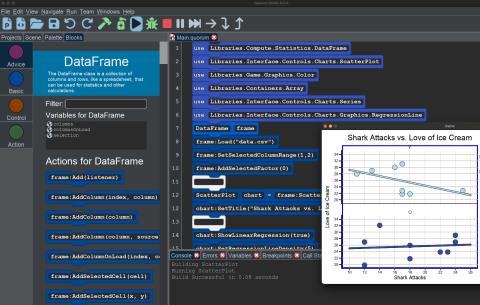Body
Image

Can Data Science be more Human Friendly and Accessible?
The overarching goal of our ITEST project is to create accessible data science tools and curriculum that are legally compliant with the Individuals with Disabilities Education Act (IDEA), Section 504 of the Rehabilitation Act of 1973, and to evaluate these materials with a diverse group of high-school aged student learners. We have created through this work a set of multi-modal data science technologies that were born accessible and have re-imagined what data science could become through first principles. In a sense, our goal is to make all aspects of data science less esoteric, easier to understand, and fully accessible to all of us. To help achieve our goal, we have worked diligently on a problem we call the "Accessible Graphics" problem, which seems to get in the way of many aspects of data science for people with disabilities. For example, students that are blind cannot create their own visualizations or interpret them. Similarly, modern programming tools use rich graphics like drag and drop connectable blocks and manipulable output. We have created modern alternatives on top of our open source accessible graphics technologies, allowing anyone to participate and innovate in data science. We have been pilot testing our technologies with people with disabilities and are conducting a large field study in classrooms across the United States starting in 2024.
Pillar 1: Innovative Use of Technologies in Learning and Teaching
Data science today lags behind many efforts in programming to make it friendlier to high school students. Naming conventions are arguably esoteric (e.g., Kruskal-Wallis) and user interfaces can be as well (e.g., a terminal in R Studio). We have created programming technologies that automatically generate accessible output, like charts, blocks, or visualizations without human intervention. We have then created a 2-week curriculum and 52 reference tutorials teachers can use to experiment and learn with their students.
Pillar 2: Partnerships for Career and Workforce Preparation.
People with disabilities have significant barriers to participation in high-paying professions like computer or data science. For example, tools for generating charts are often not accessible to users that are blind and the profession of statistics often uses very exact language that may cause everyone anxiety, but that could be especially difficult for those with specific learning disabilities. Our goal is to mitigate these and other barriers that reduce or prevent participation of students with disabilities.
Pillar 3: Strategies for Equity in STEM Education
We have established a series of strategic partnerships helping us think about these broader goals. This includes AccessCSforAll, AccessComputing, Landmark School, the Washington State School for the Blind, RStudio, the ACM Data Science Task Force, and other partners in the disabilities community. We are currently leveraging teacher partnerships throughout the US as part of a larger field study designed to help us identify barriers and improve the approach.

Discipline(s)
Data Science
Target Gradespan(s)
High school (9-12)
Target Participant(s)
Participants with disabilities
Category
Developing and Testing Innovations (DTI)